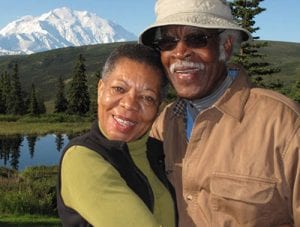Audrey Peterman’s Huffington Post blog includes American history from a Black History Month synopsis she received from her friends at the National Park Service:
“Since the start of the American conservation movement, African Americans have responded to the call to preserve and protect our National Treasures. Between 1899 and 1904 approximately 500 African American troops of the 24th Infantry and 9th Calvary served as the first park rangers at Yosemite, Sequoia, and General Grant (Kings Canyon) National Parks. These men, known as the Buffalo Soldiers, were stewards of some of the most beautiful lands that were made accessible to the public under the American conservation movement.
“That same year, Charles Young, an energetic and intelligent West Point graduate who was born into slavery in Kentucky, served as Acting Military Superintendent of Sequoia & General Grant National Park. He was the first African American to ever hold the position of Superintendent of a National Park. Under Young’s leadership, the Buffalo Soldiers achieved more in one summer than what had been accomplished by rangers during the previous three summers. This resulted in a greatly expanded road network within the park.
“In the footsteps of these soldiers, a new generation of African Americans continued to preserve and protect these special places as they came under the auspices of the National Park Service. During the Great Depression, 200,000 African American men participated in the Civilian Conservation Corps (CCC) program where their contributions were many and varied. Due to racial discrimination and legal segregation of the time, African American CCC camps were often placed on federal lands away from hostile population centers. As a result, most of the work they did took place in National Parks. They helped to build the infrastructure at some of our most iconic units including Shenandoah, Gettysburg, and Mammoth Cave.
“Carrying the baton of commitment, James Holmes became the first African American National Park ranger when he began his career at Booker T. Washington National Monument in May of 1958. Four years later, over 40 African American seasonal rangers from Historically Black Colleges joined him in fulfilling the mission of the agency. These students served in positions all over the United States, many of them setting precedence in their employment. One such individual was Robert G. Stanton who served as the first African American ranger at Grand Teton National Park. A year later African American park rangers Gordon Gun drum and Edward Footman, stood watch over Dr. Martin Luther King Jr. as he gave his famous “I have a Dream” speech on the steps of the Lincoln Memorial.
“The spirit of Charles Young was present when in 1997 Robert G. Stanton made history by becoming the 15th director of the National Park Service. He inspired other African Americans to reach for new heights by taking on more leadership positions within the agency. Since that time African Americans have continued on the march towards progress in different divisions. In recent years, the NPS has welcomed the first African American Superintendents of the Great Smoky Mountains National Park [Cassius Cash], Buffalo National River, and Harpers Ferry National Historical Park. Also, for the first time, a woman and an African American holds the position of Chief Historian for the entire agency…” [Dr. Turkiya L. Lowe.]

Audrey and Frank Peterman at Denali National Park. Photo courtesy of Audrey Peterman.
Read more about Audrey and Frank Peterman. Audrey Peterman is an advocate for public lands and for engaging a more diverse cross-section of the country in enjoying and protecting them. She is co-author of Legacy on the Land with her husband Frank, and author of Our True Nature: Finding a Zest for Life in the National Park System. When TACF spoke recently with Audrey, she shared that her husband Frank worked with chestnuts when he was Southeast Regional Director of The Wilderness Society, 2003-10.
